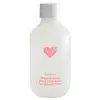What's inside
What's inside
 Key Ingredients
Key Ingredients

 Benefits
Benefits

 Concerns
Concerns

 Ingredients Side-by-side
Ingredients Side-by-side

Water
Skin ConditioningButyl Methoxydibenzoylmethane
UV AbsorberEthylhexyl Methoxycinnamate
UV AbsorberButylene Glycol
HumectantOctocrylene
UV AbsorberPolyacrylate Crosspolymer-11
Emulsion StabilisingSilica
AbrasiveGlycerin
HumectantPanthenol
Skin ConditioningPhenoxyethanol
PreservativeApium Graveolens Extract
Skin ConditioningBiosaccharide Gum-1
HumectantHoney Extract
HumectantCentella Asiatica Extract
CleansingBisabolol
MaskingLecithin
EmollientTocopheryl Acetate
AntioxidantTriethylene Glycol
Masking1,2-Hexanediol
Skin ConditioningAvena Sativa Kernel Extract
AbrasiveLactobacillus Ferment
Skin ConditioningSodium Benzoate
MaskingPotassium Sorbate
PreservativeWater, Butyl Methoxydibenzoylmethane, Ethylhexyl Methoxycinnamate, Butylene Glycol, Octocrylene, Polyacrylate Crosspolymer-11, Silica, Glycerin, Panthenol, Phenoxyethanol, Apium Graveolens Extract, Biosaccharide Gum-1, Honey Extract, Centella Asiatica Extract, Bisabolol, Lecithin, Tocopheryl Acetate, Triethylene Glycol, 1,2-Hexanediol, Avena Sativa Kernel Extract, Lactobacillus Ferment, Sodium Benzoate, Potassium Sorbate
Water
Skin ConditioningButylene Glycol
HumectantPEG-6 Caprylic/Capric Glycerides
EmulsifyingSodium PCA
HumectantNiacinamide
SmoothingAloe Barbadensis Leaf Juice
Skin ConditioningInositol
HumectantPhenoxyethanol
PreservativeCitrullus Lanatus Fruit Extract
Skin ConditioningHylocereus Undatus Extract
Skin ConditioningCentella Asiatica Extract
CleansingPanthenol
Skin ConditioningGlycyrrhiza Glabra Root Extract
BleachingFomes Officinalis Extract
Skin ProtectingHydroxypropyl Methylcellulose
Emulsion StabilisingSodium Hyaluronate
HumectantMilk Protein
Skin ConditioningTetrasodium EDTA
Tocopheryl Acetate
AntioxidantWater, Butylene Glycol, PEG-6 Caprylic/Capric Glycerides, Sodium PCA, Niacinamide, Aloe Barbadensis Leaf Juice, Inositol, Phenoxyethanol, Citrullus Lanatus Fruit Extract, Hylocereus Undatus Extract, Centella Asiatica Extract, Panthenol, Glycyrrhiza Glabra Root Extract, Fomes Officinalis Extract, Hydroxypropyl Methylcellulose, Sodium Hyaluronate, Milk Protein, Tetrasodium EDTA, Tocopheryl Acetate
 Reviews
Reviews

Ingredients Explained
These ingredients are found in both products.
Ingredients higher up in an ingredient list are typically present in a larger amount.
Butylene Glycol (or BG) is used within cosmetic products for a few different reasons:
Overall, Butylene Glycol is a safe and well-rounded ingredient that works well with other ingredients.
Though this ingredient works well with most skin types, some people with sensitive skin may experience a reaction such as allergic rashes, closed comedones, or itchiness.
Learn more about Butylene GlycolCentella Asiatica Extract (Centella) is derived from an herb native to Southeast Asia. It is famous for its anti-inflammatory and soothing properties.
Centella is rich in antioxidants and amino acids, such as Madecassic Acid and Asiaticoside.
Studies show the compounds in centella help with:
The combination of all these properties makes centella effective at soothing, hydrating, and protecting the skin.
Other great components of centella include Vitamin A, vitamin C, several B vitamins, and Asiatic Acid.
Fun fact: Centella has been used as a medicine and in food for many centuries. As a medicine, it is used to treat burns, scratches, and wounds.
Learn more about Centella Asiatica ExtractPanthenol is a common ingredient that helps hydrate and soothe the skin. It is found naturally in our skin and hair.
There are two forms of panthenol: D and L.
D-panthenol is also known as dexpanthenol. Most cosmetics use dexpanthenol or a mixture of D and L-panthenol.
Panthenol is famous due to its ability to go deeper into the skin's layers. Using this ingredient has numerous pros (and no cons):
Like hyaluronic acid, panthenol is a humectant. Humectants are able to bind and hold large amounts of water to keep skin hydrated.
This ingredient works well for wound healing. It works by increasing tissue in the wound and helps close open wounds.
Once oxidized, panthenol converts to pantothenic acid. Panthothenic acid is found in all living cells.
This ingredient is also referred to as pro-vitamin B5.
Learn more about PanthenolPhenoxyethanol is a preservative that has germicide, antimicrobial, and aromatic properties. Studies show that phenoxyethanol can prevent microbial growth. By itself, it has a scent that is similar to that of a rose.
It's often used in formulations along with Caprylyl Glycol to preserve the shelf life of products.
Tocopheryl Acetate is AKA Vitamin E. It is an antioxidant and protects your skin from free radicals. Free radicals damage the skin by breaking down collagen.
One study found using Tocopheryl Acetate with Vitamin C decreased the number of sunburned cells.
Tocopheryl Acetate is commonly found in both skincare and dietary supplements.
Learn more about Tocopheryl AcetateWater. It's the most common cosmetic ingredient of all. You'll usually see it at the top of ingredient lists, meaning that it makes up the largest part of the product.
So why is it so popular? Water most often acts as a solvent - this means that it helps dissolve other ingredients into the formulation.
You'll also recognize water as that liquid we all need to stay alive. If you see this, drink a glass of water. Stay hydrated!
Learn more about Water